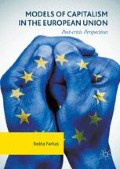Abstract
The diversity of the institutional systems, as revealed in the previous chapters, presents a major challenge for European economic integration. This chapter describes this challenge and its consequences. Obviously, this diversity is not the only challenge European integration must face. There are several challenges from outside the economy (environmental issues, climate change, the energy supply, migratory pressure, demographic problems, and so on) and from the globalised world economy (the non-decreasing backwardness in competitiveness compared to the USA and increasingly intense competition with the emerging countries), which all jeopardise the maintenance of the welfare model,1 which model is generally known as the European social market economy. Nevertheless, the discussion of all these details is well outside the scope of this book. This chapter is dedicated to those aspects that result from the main topic of this book, that is, the study of the various models of European market economies and their coexistence.
Access this chapter
Tax calculation will be finalised at checkout
Purchases are for personal use only
Bibliography
Ágh, A. (2014). Differentiated membership and core-periphery divide in the EU: Negative-regressive divergence in the new member states. Paper presented at the UACES 44th Annual Conference, Cork, 1–3 September.
Aglietta, M. (1995). The transition to EMU: Structural and strategic aspects (Research Paper No. 9511). New York: Federal Reserve Bank of New York.
Alsén, A., Gruner, K., Hansson, E., Jensen, T., Kurz, J., Larsson, S., et al. (2013). National strategy for Sweden. From wealth to well-being. Boston: The Boston Consulting Group.
Barca, F. (2009). An agenda for a reformed cohesion policy. Independent Report prepared at the request of the Commissioner for Regional Policy, Brussels.
Beckmann, R., Hebler, M., Kösters, W., & Neimke, M. (2000). Theoretische Konzepte zum Europäischen Integrationsprozeß: Ein aktueller Überblick. MPRA Paper No. 35703. Munich: University Library of Munich.
Delors Committee (Committee for the Study of Economic and Monetary Union). (1989). Report on economic and monetary union in the European community. Luxembourg: European Communities.
Dyson, K., & Featherstone, K. (1999). The road to Maastricht. Oxford: Oxford University Press.
EBRD. (2013). Stuck in transition? Transition report 2013. London: European Bank for Reconstruction and Development.
Eichengreen, B., Park, D., & Shin, K. (2013). Growth slowdowns redux: New evidence on the middle-income trap (NBER Working Paper No. 18673). Cambridge, MA: National Bureau of Economic Research.
Éltető, A. (Ed.) (2014). Mind the gap. Integration experiences of the ten Central and Eastern European countries. Budapest: Centre for Economic and Regional Studies of the Hungarian Academy of Sciences Institute of World Economics.
Erhard, L. (1955). Gedanken zum Problem der Kooperation oder der Integration in Europa. Retrieved July 27, 2013, from http://www.cvce.eu/obj/gedanken_von_ludwig_erhard_zum_problem_der_kooperation_oder_der_integration_in_europa_marz_1955-de-37cce613-deff-4b6e-9708-d1f2f0be0a47.html
European Commission. (1990). One market, one money. An evaluation of the potential benefits and costs of forming an economic and monetary union. European Economy, 44, Brussels.
European Commission. (2009a). Ageing report: Economic and budgetary projections for the EU-27 Member States (2008-2060). European Economy, 2/2009.
European Commission. (2011b). The 2012 ageing report: Underlying assumptions and projection methodologies. European Economy, 4/2011.
Farkas, B. (2013). Weakening cohesion as a security challenge for the European Union. In A. Visvizi & T. Stepniewski (Eds.), Security dimensions of Central and Eastern Europe. Yearbook of the Institute of East-Central Europe (Vol. 11(5), pp. 65–80). Lublin: Institute of East-Central Europe.
Halmai, P., & Vásáry, V. (2012). Convergence crisis: Economic crisis and convergence in the European Union. International Economics and Economic Policy, 9(3), 297–322.
IMF (2014). 25 years of transition: Post-communist Europe and the IMF. Washington, DC: International Monetary Fund.
Kenen, P. B. (1995). Economic and monetary union in Europe. Moving beyond Maastricht. Cambridge: Cambridge University Press.
Molle, W. (2001). The economics of European integration. Theory, practice, policy. Aldershot: Ashgate.
von Ondarza, N. (2013). Strengthening the core or splitting Europe? Prospects and pittfals of a strategy of differentiated integration (SWP Research Paper No. 2). Berlin: Stiftung Wissenschaft und Politik.
Szalavetz, A. (2014). Upgrading and value capture in global value chains—More complex that what the smile-curve suggests. Paper presented at the EACES Biennial Conference, Budapest, 4–6 September.
Author information
Authors and Affiliations
Copyright information
© 2016 The Author(s)
About this chapter
Cite this chapter
Farkas, B. (2016). Models of Capitalism and the Future of the European Integration. In: Models of Capitalism in the European Union. Palgrave Macmillan, London. https://doi.org/10.1057/978-1-137-60057-8_11
Download citation
DOI: https://doi.org/10.1057/978-1-137-60057-8_11
Published:
Publisher Name: Palgrave Macmillan, London
Print ISBN: 978-1-137-60056-1
Online ISBN: 978-1-137-60057-8
eBook Packages: Political Science and International StudiesPolitical Science and International Studies (R0)

